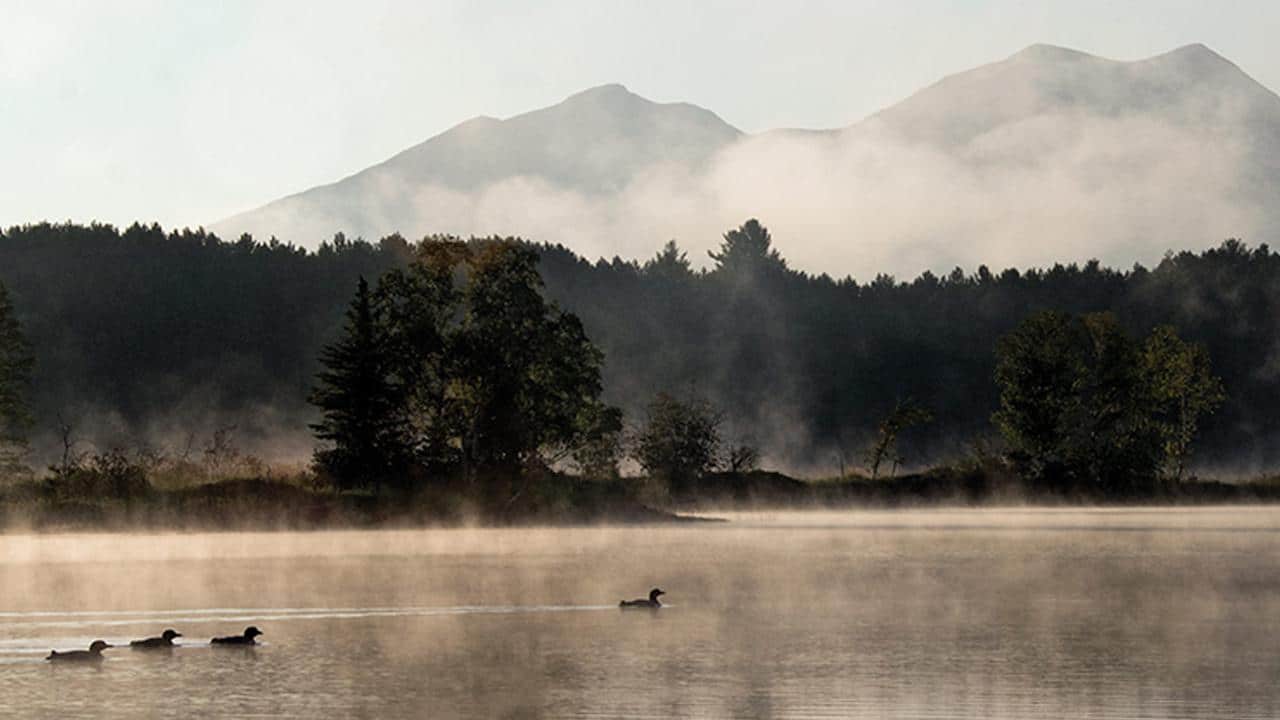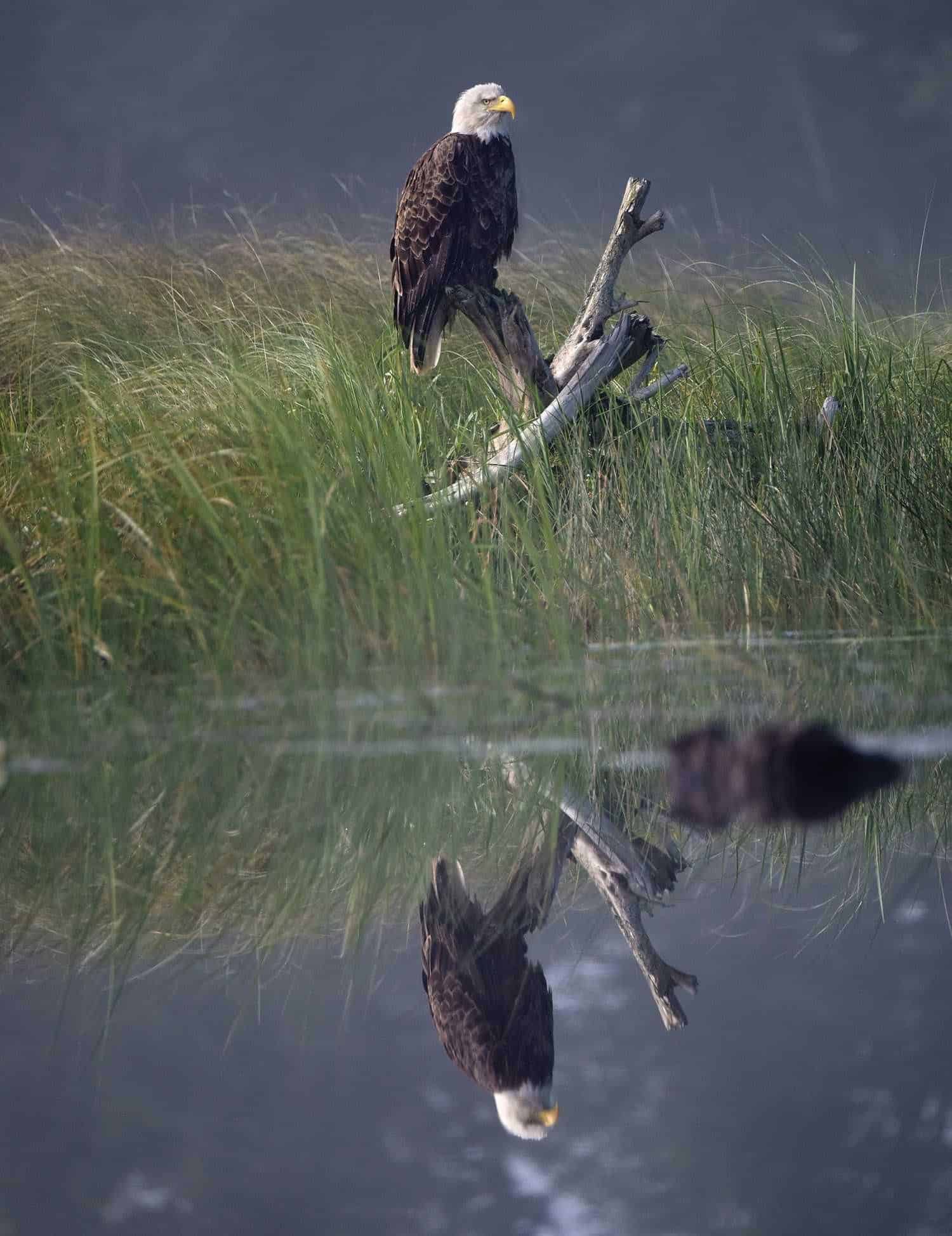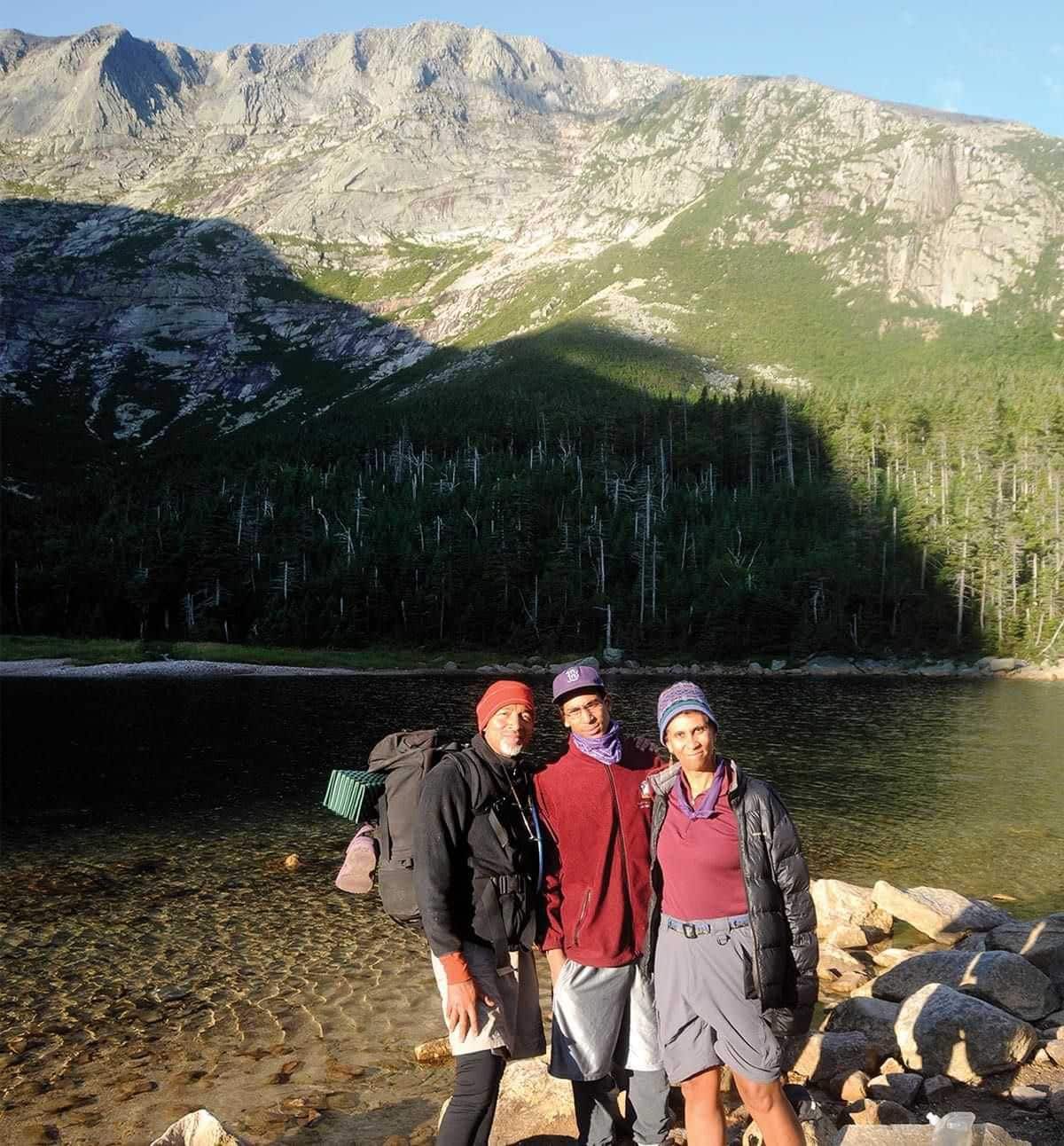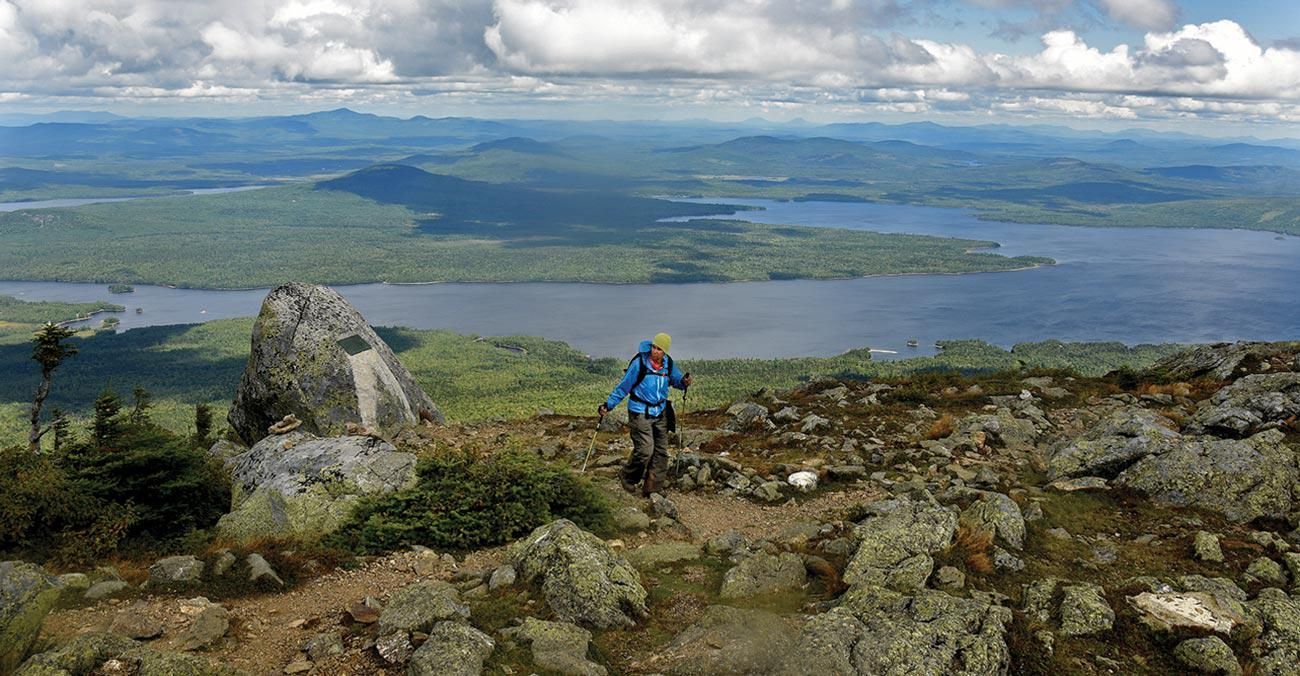

Flagstaff Lake along the A.T. in Maine. Derrick Z. Jackson
By Derrick Z. Jackson
I am the very accidental Black nature lover.
I was a typical urban boy in Milwaukee and a rabid sports fan in the 1960s. The most significant eagles to me played football in Philadelphia. The first cardinal I ever paid attention to was Bob Gibson throwing fastballs for St. Louis. My first confirmed sighting of an oriole was Frank Robinson blasting home runs for Baltimore. Bears and lions were fauna native to Chicago and Detroit and invasive species in Green Bay.
A dismal failure at actual sports, I did the next-best thing. I became a sportswriter and photographer. In college, I covered high school sports for the Milwaukee Journal. I shot for the Associated Press at Green Bay Packers games and the 1974 National Basketball Association (NBA) finals between the Milwaukee Bucks and the Boston Celtics. By 1979, at the age of 23, I was covering the New York Knicks and the NBA finals for Newsday.
That was my idea of climbing a summit, clueless of other ranges to scale.
That same year, I met a Black woman named Michelle Holmes. She was a medical student at Harvard University. In our first fall of dating, she said, “Let’s go see the foliage.”
I responded, “What’s foliage?”
A stunned Michelle said, “You know, foliage…foliage? You’re kidding. You don’t know what foliage is?”

Bald Eagle – just north of the A.T. near Umbagog Wildlife Refuge in New Hampshire. Derrick Z. Jackson
Suddenly, I flashed back to the drives in the fall from Milwaukee to Green Bay for Packers games, with farm fields rimmed by yellow, orange, and red trees. “Oh, do you mean the changing of the leaves?” Michelle nodded affirmatively and then moved on to proclaiming that we would go see the leaves on a four-day holiday weekend.
Puzzled by the notion that this would take up a whole weekend, I asked:
“How long can you look at a red leaf?”
That weekend, Michelle chose a mountain to climb. She chose no slouch. It was Mt. Tecumseh, listed as one of the White Mountain’s 4,000 footers (there is an ongoing debate as to whether it is just 3,995 feet). As we ascended, a fog so dense enveloped the mountain that my attempt to shout died inches from my lips. At the summit, Michelle despaired that I would never go hiking again because our view was the equivalent of being shrouded under a white bedsheet.
Then, hot and sweaty, I saw beads of dew glistening from a pine tree. I shook the tree to give myself a shower. The cooling effect, combined with the seductive scent of the pine, sent me into an ecstasy that shocked me. “This feels and smells sooooo good!” I told her.
At that moment, I was hooked on nature. Over the next decade, all our vacations, eventually with two little boys, involved camping in the outdoors. We camped in national parks from Acadia to Death Valley, from the Virgin Islands to the bottom of the Grand Canyon, and from the Everglades to Kings Canyon/Sequoia and Yosemite. We camped in national forests from New Hampshire to New Mexico. In 1988, we quit our old jobs at the same time and drove from Boston to Alaska, car-camping for six weeks among glaciers, eagles, moose, otters, bears, and puffins and dazzled by fields of lupines and vistas of towering peaks across from spits.
Soon after I took up my new job as a metro columnist at the Boston Globe, I was asked to give a talk at predominantly Black Roxbury Community College. In the question-and-answer period after my set speech, a young Black man asked me about my hobbies.
“Birdwatching,” I responded.
That started a giggle that rolled like a tsunami into rollicking laughter in a room of 200 people. I asked the young man, “Why do you think everyone is laughing?” He said, “You know.”
I knew where he was going, but I played dumb and said, “No, I don’t know, so tell me.”
He said, “You know what I mean.”
I said, “What do you mean?”
He said, “You know, birdwatching … that’s a White thing.”
A fresh wave of laughter swept through the room. After it subsided, I said:
“I figured that’s what you’d say. Here’s what I think.” I rattled off the names of Martin Luther King, Jr., Rosa Parks, Malcolm X, and all the world of marchers and protestors who agitated for civil rights, then said:
“They didn’t talk about it this way, but I look at what they were fighting for, and I don’t think it was just about voting rights, lunch counters, bus seats, and school desegregation. In an unspoken way, I think they also risked their lives and shed blood for our right to enjoy and take ownership of this whole nation. For me, that means my right to enjoy national parks, to care about the birds, and to feel my presence is equal to anyone else’s.”
More than 30 years later, ownership, stewardship, and my assertion that birdwatching, the outdoors, and the environment is everyone’s thing has become urgent to the point of emergency. On the more pleasant and personal side, Michelle’s love of the outdoors led her to section-hike the Appalachian Trail (A.T.) over thirteen years, finishing in 2019. I probably did about 700 miles of the Trail supporting her, including glorious traverses of the Smokies and much of the White Mountains.
Michelle’s getting me to love nature led me to become the coauthor and photographer of two books on the restoration of Atlantic puffins to islands off the coast of Maine, where they had been hunted into local extinction for nearly a century. For two decades, we together have escorted a diverse set of urban Scouts into the wilds, from canoe camping in Maine to ten nights of backpacking at the Philmont Scout Ranch in New Mexico. Our troop’s commitment to diversity led to one of our girls being in the 2021 inaugural class of female Eagle Scouts.
On the less pleasant side, climate change now bears down on us with unbearable temperatures, rising seas, and devastating storms. Black and Latinx families are disproportionately suffering from the impacts in heat islands in redlined neighborhoods and displacement by hurricanes such as Katrina in New Orleans and Harvey in Houston. That is on top of the decades of systemic environmental injustice of Black and Brown families living in injurious, disproportionate, asthmatic proximity to refining and burning of fossil fuels in industry and transportation. The chronic illnesses due to that proximity are considered a major factor in why the COVID-19 Black and Brown death rate remains double that of White victims.

Derrick Z. Jackson with his son, Tano Holmes, and wife, Michelle Holmes, at Chimney Pond in Baxter State Park, Maine. Derrick Z. Jackson
Belying the laughter of that Roxbury Community College audience over my birdwatching, people of color have for several years now actually felt more strongly than White people that climate change must be dealt with immediately. A 2015 New York Times poll found that 79 percent of Latinx respondents considered climate change to be an important problem, compared to 63 percent of White respondents. By a two to one margin, Latinx respondents considered climate change a global problem worthy of U.S. aid to low-income countries for climate mitigation.
In 2020 New York Times election battleground state polls, 84 percent of Black respondents nationally said they worry about their community being harmed by climate change, compared to 55 percent of White respondents. In Florida, two of three Black respondents and three of four Latinx respondents worry about their lives being impacted by rising seas. In Arizona, three of four Latinx respondents worry about being impacted by rising temperatures. Only half of White respondents worry about climate impacts in Florida and Arizona.
This racial divide in climate change concern is critically germane to those who envision an outdoors recreation scene where Black and Brown people backpack along trails such as the A.T. in proportion to their share of the nation’s population. According to the very latest analysis by the Brookings Institution, the White population in the U.S., once close to 90 percent for the first half of the 20th century, will likely slip under 60 percent in the 2020 census. That means that four of every ten hikers over all and every other hiker under the age of 25 should be of color to mirror the demographics of this country.
As an outdoor enthusiast, bird author, and journalist, I straddle a knife’s edge between the enjoyment and conservation of natural beauty and the ugliness of environmental injustice and the very public racial turmoil that has engulfed many old-line environmental organizations as staff people of color demand much more than token inclusiveness from White executives. I’m appreciative of the increasing number of books and essays by Black people chronicling their individual journeys into nature and digging for a more truthful history of the Black experience in outdoor spaces, which includes helping to build and protect national parks, only to endure segregated facilities during Jim Crow.
As someone who — again inspired by Michelle’s vision — ritually camped with Black friends on Memorial Day weekend from our mid-20s to our mid-40s, I smile when I read of new hiking groups, outdoor collaboratives, and environmental journalist networks led by people of color. I wrote in celebration over the 2020 presidential election and the Georgia Senate runoffs for how environmental justice voters showed up big, so big that President Biden’s cabinet has an unprecedented number of officials with a track record of fighting against unjust pollution and poisoning of communities of color.
Of course, all this represents just the beginning of a new day. How bright that day becomes will significantly depend on how the predominately White environmental and conservation world responds to all of this. Last year, amid the upheaval over police brutality that ignited sweeping reexaminations of systemic racism, legacy environmental groups claimed to understand they had a role in the reckoning.

Michelle Holmes traversing the Bigelow Mountains on the A.T. in Maine. Derrick Z. Jackson
Websites are full of acknowledgement that the land we all hike on was stolen from Indigenous peoples. Several organizations offered confessionals on the past racist beliefs of founders and decades of White supremacy culture that alienated potential talent of color. Many groups have made environmental justice part of their portfolio and forging partnerships with communities to assist in their fights against pollution and systemically poor infrastructure.
It has finally dawned on environmental leaders, at least rhetorically, that a movement symbolized so long by melting ice and polar bears must meld into a more holistic vision. It is hard to invite people to put on some hiking boots to meditate on the carpets of trillium and tunnels of rhododendron along the A.T. in the South or marvel at scarlet tanagers zipping through the canopy or ravens soaring around the barren peaks of the New Hampshire White Mountains if they can’t open their windows in the city during a heat wave because of blowing industrial soot. At some point, environmentalism and environmental justice must stop being two separate words.
The polls say people of color in the U.S. understand that more clearly than White residents. The former are ready to get cracking on getting rid of pollution and being full players and leaders in the green economy, while the latter remains hesitant. In a survey last fall commissioned by West Harlem Environmental Action (WEACT) and the Environmental Defense Fund, 60 percent of Black adults say they are very concerned about air pollution in their community, compared to only 32 percent of White adults. Black and Latinx respondents score higher than White respondents on saying “Clean energy jobs are for people like me.”
The reality is that old-line environmental groups face an unspoken challenge equal to any effort to create safe spaces for people of color in the outdoors or in their offices.
They must work toward unity among White people about the urgency of climate change, its interplay with environmental injustice, long-term threats to our economy, and the unavoidable need to part with tax dollars both domestically and abroad for clean-ups and clean energy. The hardest part will be to convince White people of their collective systemic privileges to delay, avoid, or recover from the worst impacts of a boiling planet.
The advantages are endless. In hot places, it could be the affordability of air conditioning and living in naturally cooler areas because of tree canopies and parks. In coastal areas, it could be sturdier homes, car ownership to evacuate to higher ground, or quicker access to federal emergency funds if homes are damaged or destroyed after floods and hurricanes. Just about everywhere, it is the relative lack of living with — and choking on — fossil soot. Groundbreaking studies have shown that, while White people account for most of the pollution in consumer activity, Black and Latinx communities disproportionately breathe it in.
Environmental groups must get White people to account for these advantages in an equitable climate strategy on the daily home-front to have any long-term credibility on inviting people of color into the outdoors on the weekend. As of now, White people collectively refuse to account for them. A 2019 Pew survey found that, while 68 percent of Black respondents thought White people benefit “a great deal” from advantages Black people don’t have, only 23 percent of White respondents said they benefit a great deal from their advantages. A 2020 NBC News/Wall Street Journal poll found that only 23 percent of White respondents said they receive “too many special advantages.”
White denial of advantage cannot be soft-pedaled by environmental leaders after the surge of White supremacy during and after the two terms of Barack Obama, the nation’s first Black president. The last decade has seen the tragedies in Charlottesville, Virginia, Charleston, South Carolina, the police and vigilante murders of Black people, and the insurrection of January 6, 2021. They cannot be soft-pedaled as forces are on a relentless march to roll back or stymie environmental protections that would degrade daily life and the outdoors for all of us. Denial of advantage is its own fatal disadvantage. Take COVID-19. Black and Brown people remain twice as likely to die from infections, yet 350,000 White people have died. Try to find the advantage there.
In imagining equality in the United States, Martin Luther King, Jr., invoked the imagery of the outdoors in his 1963 “I Have a Dream” speech. He said:
“Let freedom ring from the prodigious hilltops of New Hampshire. Let freedom ring from the mighty mountains of New York. Let freedom ring from the heightening Alleghenies of Pennsylvania. Let freedom ring from the snowcapped Rockies of Colorado. Let freedom ring from the curvaceous slopes of California.
“But not only that, let freedom ring from Stone Mountain of Georgia. Let freedom ring from Lookout Mountain of Tennessee. Let freedom ring from every hill and molehill of Mississippi. From every mountainside, let freedom ring.”
Now that we are reimagining the outdoors for all, on every mountainside, we must come to grips that this quest is no longer just about my wife getting me to look at a red leaf or old-line environmental groups hiring “outreach” staff to get people of color out into pristine wilderness.
Environmentalism also must ring down from the mountains to ring out soot in our cities, fight for clean water, and protect people from the rising seas. If we can replace environmental injustice with a true commitment toward pristine environs where people live every day, I can guarantee that a whole lot of people will feel a lot more welcome to climb an actual summit and shake down some dew from a tree.
Derrick Z. Jackson is the 2021 Scripps Howard winner for Excellence in Opinion Writing and the 2021 winner in both Social Justice and Sports commentary from the National Society of Newspaper Columnists. He is co-author of “The Puffin Plan,” winner in Teen Nonfiction from the Independent Book Publishers Association. Published in 2020 by Tumblehome Books.
Reposted with permission from AT Journeys (the magazine of the Appalachian Trail Conservancy).
- 8 Ways to Invite Nature Into Your Daily Life - EcoWatch
- People of Color Breathe More Polluted Air, New Research Confirms ...

 233k
233k  41k
41k  Subscribe
Subscribe 